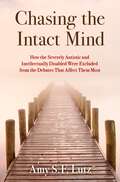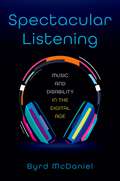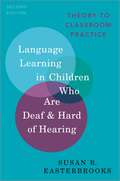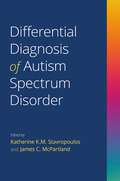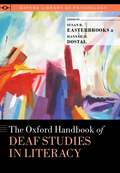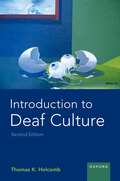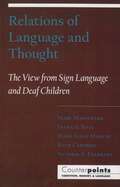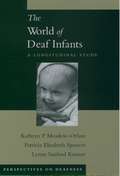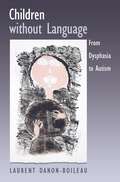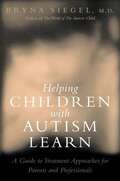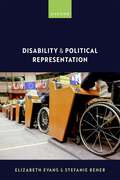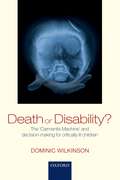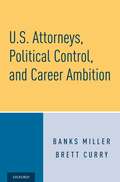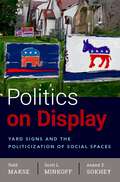- Table View
- List View
Chasing the Intact Mind: How the Severely Autistic and Intellectually Disabled Were Excluded from the Debates That Affect Them Most
by Amy S. LutzA comprehensive introduction to the concept of the "intact mind" and how it affects disability policy and practice. The concept of the intact mind, first described in a 2006 memoir, refers to the idea that inside every autistic child is an intelligent, typical child waiting to be liberated by the right diet, the right treatment intervention, the right combination of supports and accommodations. The sentiment itself is not new. Emerging largely out of psychoanalytic theory dating back to the end of the 19th century, the intact mind was later amplified in memoirs, where parents wrote of their tireless efforts to free their children from the grip of autism. Though the idea gives hope to parents devastated by a child's diagnosis, Amy Lutz argues that it has also contributed to widespread dismantling of services badly needed by severely disabled children and their families. In Chasing the Intact Mind, Lutz traces the history of the intact mind concept, explaining how it influences current policy and practice affecting those with autism. Lutz provides a historical analysis of the intact mind narrative and describes how the concept--originally unique to autism--has come to inform current debates at the heart of intellectual and developmental disability practice and policy in the United States, including battles over sheltered workshops, legal guardianship, and facilitated communication. Lutz argues that focusing on the intact mind and marginalizing those with severe disability reproduces historic patterns of discrimination that yoked human worth to intelligence, and that it is only by making space for the impaired mind that we will be able to resolve these ongoing clashes--as well as even larger questions of personhood, dependency, and care.
Chasing the Intact Mind: How the Severely Autistic and Intellectually Disabled Were Excluded from the Debates That Affect Them Most
by Amy S. LutzA comprehensive introduction to the concept of the "intact mind" and how it affects disability policy and practice. The concept of the intact mind, first described in a 2006 memoir, refers to the idea that inside every autistic child is an intelligent, typical child waiting to be liberated by the right diet, the right treatment intervention, the right combination of supports and accommodations. The sentiment itself is not new. Emerging largely out of psychoanalytic theory dating back to the end of the 19th century, the intact mind was later amplified in memoirs, where parents wrote of their tireless efforts to free their children from the grip of autism. Though the idea gives hope to parents devastated by a child's diagnosis, Amy Lutz argues that it has also contributed to widespread dismantling of services badly needed by severely disabled children and their families. In Chasing the Intact Mind, Lutz traces the history of the intact mind concept, explaining how it influences current policy and practice affecting those with autism. Lutz provides a historical analysis of the intact mind narrative and describes how the concept--originally unique to autism--has come to inform current debates at the heart of intellectual and developmental disability practice and policy in the United States, including battles over sheltered workshops, legal guardianship, and facilitated communication. Lutz argues that focusing on the intact mind and marginalizing those with severe disability reproduces historic patterns of discrimination that yoked human worth to intelligence, and that it is only by making space for the impaired mind that we will be able to resolve these ongoing clashes--as well as even larger questions of personhood, dependency, and care.
Spectacular Listening: Music and Disability in the Digital Age
by Byrd McDanielImagine a powerful listening experience that you want to share with others. You could describe it to someone with words, or you may choose a flashier alternative. You could, for example, costume yourself and take to the stage in a famous concert venue, delivering a rousing air guitar interpretation of a beloved rock solo for a live audience. Maybe you seek something more subtle, so you pull out your smartphone and record yourself lip-syncing to a guilty pleasure, showing your followers how seamlessly the music fits your movements. Perhaps instead you want others to hear how the music makes you feel, which leads you to record a podcast episode that translates the thrill of listening into audible exclamations. In ways both mundane and sensational, listening can be an expressive act, enabling people to stage consumption as a public practice -- what author Byrd McDaniel calls "spectacular listening." Contemporary digital platforms not only support such activity but actively encourage people to package personal music reception into a performance that may be widely shared. With a range of compelling ethnographic case studies, McDaniel investigates a broad shift in contemporary listening norms and the stakes for listeners with disabilities. He reveals how listening-as-performance can be an opportunity for play, as well as a critical practice that exposes ableism in music institutions, technologies, and discourse.
Spectacular Listening: Music and Disability in the Digital Age
by Byrd McDanielImagine a powerful listening experience that you want to share with others. You could describe it to someone with words, or you may choose a flashier alternative. You could, for example, costume yourself and take to the stage in a famous concert venue, delivering a rousing air guitar interpretation of a beloved rock solo for a live audience. Maybe you seek something more subtle, so you pull out your smartphone and record yourself lip-syncing to a guilty pleasure, showing your followers how seamlessly the music fits your movements. Perhaps instead you want others to hear how the music makes you feel, which leads you to record a podcast episode that translates the thrill of listening into audible exclamations. In ways both mundane and sensational, listening can be an expressive act, enabling people to stage consumption as a public practice -- what author Byrd McDaniel calls "spectacular listening." Contemporary digital platforms not only support such activity but actively encourage people to package personal music reception into a performance that may be widely shared. With a range of compelling ethnographic case studies, McDaniel investigates a broad shift in contemporary listening norms and the stakes for listeners with disabilities. He reveals how listening-as-performance can be an opportunity for play, as well as a critical practice that exposes ableism in music institutions, technologies, and discourse.
Spectacular Listening: Music and Disability in the Digital Age
by Byrd McDanielImagine a powerful listening experience that you want to share with others. You could describe it to someone with words, or you may choose a flashier alternative. You could, for example, costume yourself and take to the stage in a famous concert venue, delivering a rousing air guitar interpretation of a beloved rock solo for a live audience. Maybe you seek something more subtle, so you pull out your smartphone and record yourself lip-syncing to a guilty pleasure, showing your followers how seamlessly the music fits your movements. Perhaps instead you want others to hear how the music makes you feel, which leads you to record a podcast episode that translates the thrill of listening into audible exclamations. In ways both mundane and sensational, listening can be an expressive act, enabling people to stage consumption as a public practice -- what author Byrd McDaniel calls "spectacular listening." Contemporary digital platforms not only support such activity but actively encourage people to package personal music reception into a performance that may be widely shared. With a range of compelling ethnographic case studies, McDaniel investigates a broad shift in contemporary listening norms and the stakes for listeners with disabilities. He reveals how listening-as-performance can be an opportunity for play, as well as a critical practice that exposes ableism in music institutions, technologies, and discourse.
Language Learning in Children Who Are Deaf and Hard of Hearing: Theory to Classroom Practice (Professional Perspectives on Deafness: Evidence and Applications)
by Susan R. EasterbrooksThis volume is the long-awaited revision of the only textbook on primary language instruction written with classroom teachers of deaf and hard-of-hearing children (TODs) in mind. It builds on the work of the previous edition, describing the experiences of four real TODs and demonstrates practical application of the concepts discussed. Up-to-date chapters on theory of language learning, assessment, and evidence-based practice supplement specific examples of real cases in the field. Avoiding promotion of one teaching philosophy over another, this volume demonstrates the commonalities across classroom language instruction approaches for DHH children and helps guide teachers to enhance learning outcomes.
Language Learning in Children Who Are Deaf and Hard of Hearing: Theory to Classroom Practice (Professional Perspectives on Deafness: Evidence and Applications)
by Susan R. EasterbrooksThis volume is the long-awaited revision of the only textbook on primary language instruction written with classroom teachers of deaf and hard-of-hearing children (TODs) in mind. It builds on the work of the previous edition, describing the experiences of four real TODs and demonstrates practical application of the concepts discussed. Up-to-date chapters on theory of language learning, assessment, and evidence-based practice supplement specific examples of real cases in the field. Avoiding promotion of one teaching philosophy over another, this volume demonstrates the commonalities across classroom language instruction approaches for DHH children and helps guide teachers to enhance learning outcomes.
Differential Diagnosis of Autism Spectrum Disorder
by Katherine K. M. Stavropoulos and James C. McpartlandDifferential Diagnosis of Autism Spectrum Disorder provides a framework for clinical considerations and best practices related to diagnosing children with autism spectrum disorder (ASD) versus commonly co-occurring conditions. Differential diagnosis is a complex process, and it is common for clinicians to observe symptom overlap between conditions. In this comprehensive text, the authors focus on the similarities and differences between ASD and a second diagnosis. Leading experts provide practical guidance in the diagnostic process for ASD versus a second condition, such as anxiety or attention deficit/hyperactivity disorder. Each chapter includes clinical case studies to provide real-world examples of how clinicians make diagnostic decisions. Ample illustrations and 'decision trees' provide a visual representation of clinical decision-making.
Differential Diagnosis of Autism Spectrum Disorder
Differential Diagnosis of Autism Spectrum Disorder provides a framework for clinical considerations and best practices related to diagnosing children with autism spectrum disorder (ASD) versus commonly co-occurring conditions. Differential diagnosis is a complex process, and it is common for clinicians to observe symptom overlap between conditions. In this comprehensive text, the authors focus on the similarities and differences between ASD and a second diagnosis. Leading experts provide practical guidance in the diagnostic process for ASD versus a second condition, such as anxiety or attention deficit/hyperactivity disorder. Each chapter includes clinical case studies to provide real-world examples of how clinicians make diagnostic decisions. Ample illustrations and 'decision trees' provide a visual representation of clinical decision-making.
The Oxford Handbook of Deaf Studies in Literacy (Oxford Library of Psychology)
by Susan R. Easterbrooks Hannah M. DostalThe Oxford Handbook of Deaf Studies in Literacy brings together state-of-the-art research on literacy learning among deaf and hard of hearing learners (DHH). With contributions from experts in the field, this volume covers topics such as the importance of language and cognition, phonological or orthographic awareness, morphosyntactic and vocabulary understanding, reading comprehension and classroom engagement, written language, and learning among challenged populations. Avoiding sweeping generalizations about DHH readers that overlook varied experiences, this volume takes a nuanced approach, providing readers with the research to help DHH students gain competence in reading comprehension.
The Oxford Handbook of Deaf Studies in Literacy (Oxford Library of Psychology)
The Oxford Handbook of Deaf Studies in Literacy brings together state-of-the-art research on literacy learning among deaf and hard of hearing learners (DHH). With contributions from experts in the field, this volume covers topics such as the importance of language and cognition, phonological or orthographic awareness, morphosyntactic and vocabulary understanding, reading comprehension and classroom engagement, written language, and learning among challenged populations. Avoiding sweeping generalizations about DHH readers that overlook varied experiences, this volume takes a nuanced approach, providing readers with the research to help DHH students gain competence in reading comprehension.
Introduction to Deaf Culture (PROF PERSPECTIVES ON DEAFNESS SERIES)
by Thomas K. HolcombThomas K Holcomb's highly successful textbook on Deaf culture has been fully revised and updated in this second edition. The changes reflect those in the field and include three new chapters focusing on the impact of technology on the Deaf experience, the roles of allies in supporting the Deaf community, and the diversity that exists in the Deaf community. Also new to this edition is an ASL summary of each chapter, making the book accessible in two languages that are important in the Deaf community, ASL and English. The book provides a broad yet in-depth exploration of how Deaf people are best understood from a cultural perspective. It explores the tension between the Deaf and disabled communities, the cultural norms of the Deaf community, Deaf art and literature, the solutions being offered by the medical and Deaf communities for effective living as Deaf individuals, and an analysis of the universality of the Deaf experience. As a member of a multigenerational Deaf family with a lifetime of experience living bi-culturally among Deaf and hearing people, author Thomas K. Holcomb enhances the academic discussions with engaging stories and the poetry and art of Deaf individuals. In addition to being used in college-level courses, this book can also help parents and educators of Deaf children understand the world of Deaf culture. It offers a beautiful introduction to the ways Deaf people effectively manage their lives in a world full of people who hear.
Introduction to Deaf Culture (PROF PERSPECTIVES ON DEAFNESS SERIES)
by Thomas K. HolcombThomas K Holcomb's highly successful textbook on Deaf culture has been fully revised and updated in this second edition. The changes reflect those in the field and include three new chapters focusing on the impact of technology on the Deaf experience, the roles of allies in supporting the Deaf community, and the diversity that exists in the Deaf community. Also new to this edition is an ASL summary of each chapter, making the book accessible in two languages that are important in the Deaf community, ASL and English. The book provides a broad yet in-depth exploration of how Deaf people are best understood from a cultural perspective. It explores the tension between the Deaf and disabled communities, the cultural norms of the Deaf community, Deaf art and literature, the solutions being offered by the medical and Deaf communities for effective living as Deaf individuals, and an analysis of the universality of the Deaf experience. As a member of a multigenerational Deaf family with a lifetime of experience living bi-culturally among Deaf and hearing people, author Thomas K. Holcomb enhances the academic discussions with engaging stories and the poetry and art of Deaf individuals. In addition to being used in college-level courses, this book can also help parents and educators of Deaf children understand the world of Deaf culture. It offers a beautiful introduction to the ways Deaf people effectively manage their lives in a world full of people who hear.
Relations of Language and Thought: The View from Sign Language and Deaf Children (Counterpoints: Cognition, Memory, and Language)
by Marc Marschark Patricia Siple Diane Lillo-Martin Ruth Campbell Victoria S. EverhartThe relationship of language to cognition, especially in development, is an issue that has occupied philosophers, psychologists, and linguists for centuries. In recent years, the scientific study of sign languages and deaf individuals has greatly enhanced our understanding of deafness, language, and cognition. This Counterpoints volume considers the extent to which the use of sign language might affect the course and character of cognitive development, and presents a variety of viewpoints in this debate. This volume brings the language-thought discussion into a clearer focus, both theoretically and practically, by placing it in the context of children growing up deaf and the influences of having sign language as their primary form of communication. The discussion is also sharpened by having internationally recognized contributors, such as Patricia Siple, Diane Lillo-Martin, and Ruth Campbell, with specialties in varied areas, all converging on a common interest in which each has conducted empirical research. These contributors clarify and challenge the theoretical assumptions that have driven arguments in the language-thought debate for centuries. An introduction by the editors provides a historical overview of the issues as well as a review of empirical findings that have been offered in response to questions about language-thought relations in deaf children. The final chapters are structured in the form of "live" debate, in which each contributor is given the opportunity to respond to the other perspectives presented in this volume.
Relations Of Language And Thought: The View From Sign Language And Deaf Children
by Victoria S. Everhart Marc Marschark Patricia Siple Diane Lillo-Martin Ruth CampbellThe World of Deaf Infants: A Longitudinal Study (Perspectives on Deafness)
by Kathryn P. Meadow-Orlans Patricia Elizabeth Spencer Lynne Sanford KoesterWhat is the impact of an infant's diminished hearing on the infant and its parents? How does communication develop in cases of diminished hearing? How does diminished hearing affect social and cognitive development? What types of early interventions can improve communication and development in infants with diminished hearing? The World of Deaf Infants presents the results of a 15-year research study that addresses these questions. Through their research, perhaps the largest, long-term comparison of deaf and hearing infants, Meadow-Orlans's team provides a comprehensive and intimate look into the world of deaf infants. For a core group of 80 families that includs all four combinations of parent-infant hearing status, data was collected longitudinally at 9, 12, 15, and 18 months, and mother-infant interactions were recorded and observed in both structured and unstructured settings. Mothers' facial, vocal, and tactile behaviors during interactions were related to infants' temperament and stress; mothers' linguistic and communication behaviors, as well as their overall responsiveness, were related to children's language; and the effects of support provided to mothers were evaluated and explored. The results were dramatic, particularly those on infant attachment behaviors and the importance of visual attention to the overall development of deaf infants. This comprehensive work provides a foundation on which researchers, teachers, students, and parents can build to improve communication, cognitive and social development, and to enhance the world of deaf infants.
Children without Language: From Dysphasia to Autism
by Laurent Danon-BoileauCommunication and language disorders are often considered from one particular point of view - either psychological or neurological. Danon-Boileau argues that this is a serious mistake. He emphasizes that a child's trouble can stem from a variety of causes: neurological problems similar to those of aphasia, cognitive impairments, and psychological disorders, and, thus, the interaction of these elements needs to be taken into account. In precise case studies, Danon-Boileau describes the situations he has confronted and traces the causes of changes in the child when they happen. Combining linguistic, cognitive, and psycholanalytic approaches, Children without Language provides a unique perspective on speech and communication disorders in children and will be an essential volume for speech therapists, developmental psychologists, linguistics scholars and anyone wishing to reflect seriously on why we speak and how communication occurs.
Helping Children With Autism Learn: Treatment Approaches For Parents And Professionals
by Bryna SiegelBryna Siegel gives parents of autistic children what they need most: hope. Her first book, The World of the Autistic Child, became an instant classic, illuminating the inaccessible minds of afflicted children. Now she offers an equally insightful, thoroughly practical guide to treating thelearning disabilities associated with this heartbreaking disorder. The trouble with treating autism, Siegel writes, is that it is a spectrum disorder--a combination of a number of symptoms and causes. To one extent or another, it robs the child of social bonds, language, and intimacy--but the extent varies dramatically in each case. The key is to understandeach case of autism as a discrete set of learning disabilities, each of which must be treated individually. Siegel explains how to take an inventory of a child's particular disabilities, breaks down the various kinds unique to autism, discusses our current knowledge about each, and reviews theexisting strategies for treating them. There is no simple cure for this multifarious disorder, she writes; instead, an individual program, with a unique array of specific treatments, must be constructed for each child. She gives practical guidance for fashioning such a program, empowering parents totake the lead in their child's treatment. At the same time, she cautions against the proliferating, but questionable, treatments hawked to afflicted families. She knows the panic to do something, anything, to help an autistic child, and she offers parents reassurance and support as well as sensibleadvice, combining knowledge from experience, theory and research. For parents, autism in a child is heartbreaking. But it need not be overwhelming. Bryna Siegel offers a new understanding, and a practical, thoughtful approach, that will give parents new hope.
Disability and Political Representation
by Prof Elizabeth Evans Dr Stefanie ReherDisability and Political Representation explores how disabled people experience the various stages and aspects of the representation process, drawing upon extensive empirical research and a variety of qualitative and quantitative data. It discusses why increasing the number of disabled politicians matters, not only as a matter of justice and equality but also to better represent the issues and interests of importance to disabled people. Evans and Reher identify a variety of ableist barriers prevent disabled people from fully participating in the political process, from disenfranchisement and inaccessible polling stations to prejudice within parties and a lack of financial support for candidates who require adjustments. The work shows that while the preferences of disabled citizens are currently under-represented in parliament, disabled representatives often draw on their lived experience to advocate for their interests. The concept of experiential representation is developed to help scholars and practitioners better navigate the concept of political representation, specifically as it relates to disability. Thus, the book explores how disability can help us think about the contours of political representation. It presents and analyses a range of diverse and original data, including qualitative data generated from interviews with disabled politicians and activists in the UK, quantitative survey data on the political attitudes and participation of disabled citizens from across Europe, and data from survey experiments examining voter perceptions of disabled politicians in the UK and the US.
Disability and Political Representation
by Prof Elizabeth Evans Dr Stefanie ReherDisability and Political Representation explores how disabled people experience the various stages and aspects of the representation process, drawing upon extensive empirical research and a variety of qualitative and quantitative data. It discusses why increasing the number of disabled politicians matters, not only as a matter of justice and equality but also to better represent the issues and interests of importance to disabled people. Evans and Reher identify a variety of ableist barriers prevent disabled people from fully participating in the political process, from disenfranchisement and inaccessible polling stations to prejudice within parties and a lack of financial support for candidates who require adjustments. The work shows that while the preferences of disabled citizens are currently under-represented in parliament, disabled representatives often draw on their lived experience to advocate for their interests. The concept of experiential representation is developed to help scholars and practitioners better navigate the concept of political representation, specifically as it relates to disability. Thus, the book explores how disability can help us think about the contours of political representation. It presents and analyses a range of diverse and original data, including qualitative data generated from interviews with disabled politicians and activists in the UK, quantitative survey data on the political attitudes and participation of disabled citizens from across Europe, and data from survey experiments examining voter perceptions of disabled politicians in the UK and the US.
Death Or Disability?: The 'carmentis Machine' And Decision-making For Critically Ill Children
by Dominic WilkinsonIn ancient Rome parents would consult the priestess Carmentis shortly after birth to obtain prophecies of the future of their newborn infant. Today, parents and doctors of critically ill children consult a different oracle. Neuroimaging provides a vision of the child's future, particularly of the nature and severity of any disability. Based on the results of brain scans and other tests doctors and parents face heart-breaking decisions about whether or not to continue intensive treatment or to allow the child to die. Paediatrician and ethicist Dominic Wilkinson looks at the profound and contentious ethical issues facing those who work in intensive care caring for critically ill children and infants. When should infants or children be allowed to die? How accurate are predictions of future quality of life? How much say should parents have in these decisions? How should they deal with uncertainty about the future? He combines philosophy, medicine and science to shed light on current and future dilemmas.
U.S. Attorneys, Political Control, and Career Ambition
by Banks Miller Brett CurryUnited States Attorneys (USAs), the chief federal prosecutors in each judicial district, are key in determining how the federal government uses coercive force against its citizens. How much control do national political actors exert over the prosecutorial decisions of USAs? This book investigates this question using a unique dataset of federal criminal prosecutions between 1986 and 2015 that captures both decisions by USAs to file cases as well as the sentences that result. Utilizing intuitions from principal-agent theory, work on the career ambition of bureaucrats and politicians, and selected case-studies, the authors develop and advance a set of hypotheses about control by the President and Congress. Harnessing variation across time, federal judicial districts, and five legal issue areas - immigration, narcotics, terrorism, weapons, and white-collar crime - Miller and Curry find that USAs are subject to considerable executive influence in their decision making, supporting findings about the increase of presidential power over the last three decades. In addition, they show that the ability of the President to appoint USAs to higher-level positions within the executive branch or to federal judgeships is an important mechanism of that control. This investigation sheds light on how the need to be responsive to popularly-elected principals channels the enormous prosecutorial discretion of USAs.
U.S. Attorneys, Political Control, and Career Ambition
by Banks Miller Brett CurryUnited States Attorneys (USAs), the chief federal prosecutors in each judicial district, are key in determining how the federal government uses coercive force against its citizens. How much control do national political actors exert over the prosecutorial decisions of USAs? This book investigates this question using a unique dataset of federal criminal prosecutions between 1986 and 2015 that captures both decisions by USAs to file cases as well as the sentences that result. Utilizing intuitions from principal-agent theory, work on the career ambition of bureaucrats and politicians, and selected case-studies, the authors develop and advance a set of hypotheses about control by the President and Congress. Harnessing variation across time, federal judicial districts, and five legal issue areas - immigration, narcotics, terrorism, weapons, and white-collar crime - Miller and Curry find that USAs are subject to considerable executive influence in their decision making, supporting findings about the increase of presidential power over the last three decades. In addition, they show that the ability of the President to appoint USAs to higher-level positions within the executive branch or to federal judgeships is an important mechanism of that control. This investigation sheds light on how the need to be responsive to popularly-elected principals channels the enormous prosecutorial discretion of USAs.
POLITICS ON DISPLAY C: Yard Signs and the Politicization of Social Spaces
by Todd Makse Scott Minkoff Anand SokheyPolitical yard signs are one of the most ubiquitous and conspicuous features of American political campaigns, yet they have received relatively little attention as a form of political communication or participation. In Politics on Display, Todd Makse, Scott L. Minkoff, and Anand E. Sokhey tackle this phenomenon to craft a larger argument about the politics of identity and space in contemporary America. Documenting political life in two suburban communities and a major metropolitan area, they use an unprecedented research design that leverages street-level observation of the placement of yard signs and neighborhood-specific survey research that delves into the attitudes, behavior, and social networks of residents. The authors then integrate these data into a geo-database that also includes demographic and election data. Supplemented by nationally-representative data sources, the book brings together insights from political communication, political psychology, and political geography. Against a backdrop of conflict and division, this book advances a new understanding of how citizens experience campaigns, why many still insist on airing their views in public, and what happens when social spaces become political spaces.
Politics on Display: Yard Signs and the Politicization of Social Spaces
by Todd Makse Scott Minkoff Anand SokheyPolitical yard signs are one of the most ubiquitous and conspicuous features of American political campaigns, yet they have received relatively little attention as a form of political communication or participation. In Politics on Display, Todd Makse, Scott L. Minkoff, and Anand E. Sokhey tackle this phenomenon to craft a larger argument about the politics of identity and space in contemporary America. Documenting political life in two suburban communities and a major metropolitan area, they use an unprecedented research design that leverages street-level observation of the placement of yard signs and neighborhood-specific survey research that delves into the attitudes, behavior, and social networks of residents. The authors then integrate these data into a geo-database that also includes demographic and election data. Supplemented by nationally-representative data sources, the book brings together insights from political communication, political psychology, and political geography. Against a backdrop of conflict and division, this book advances a new understanding of how citizens experience campaigns, why many still insist on airing their views in public, and what happens when social spaces become political spaces.
